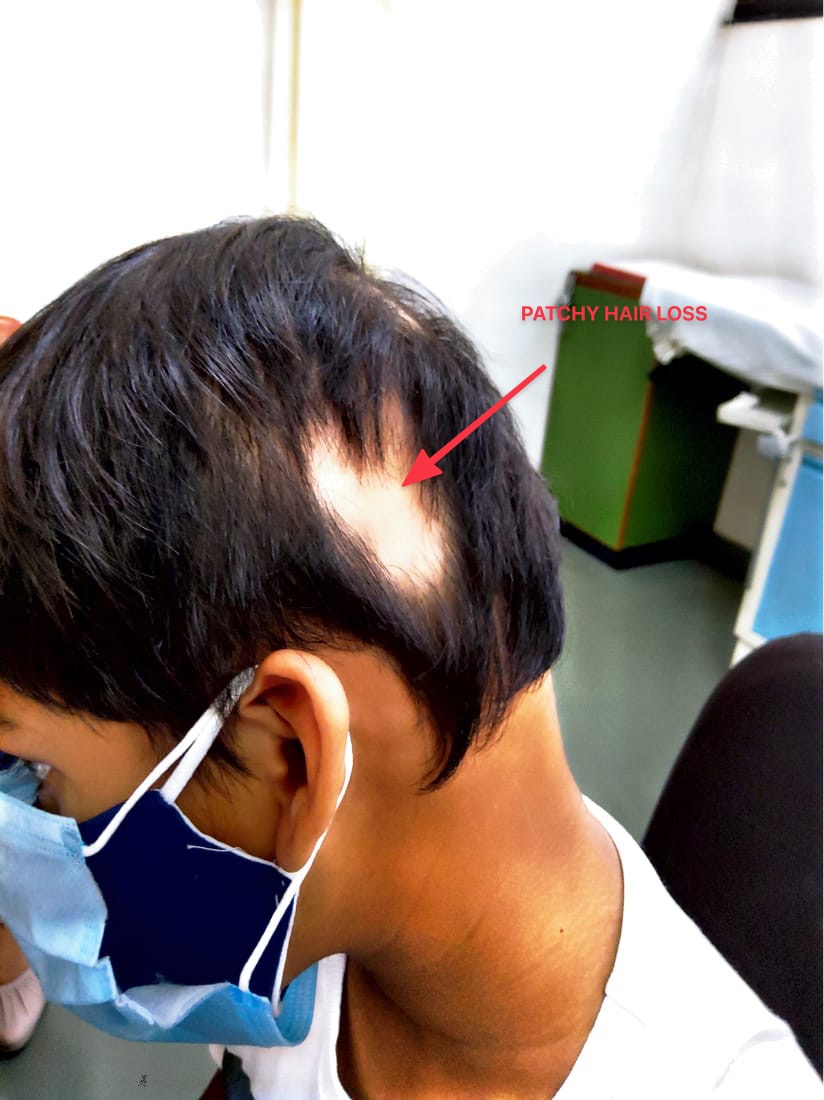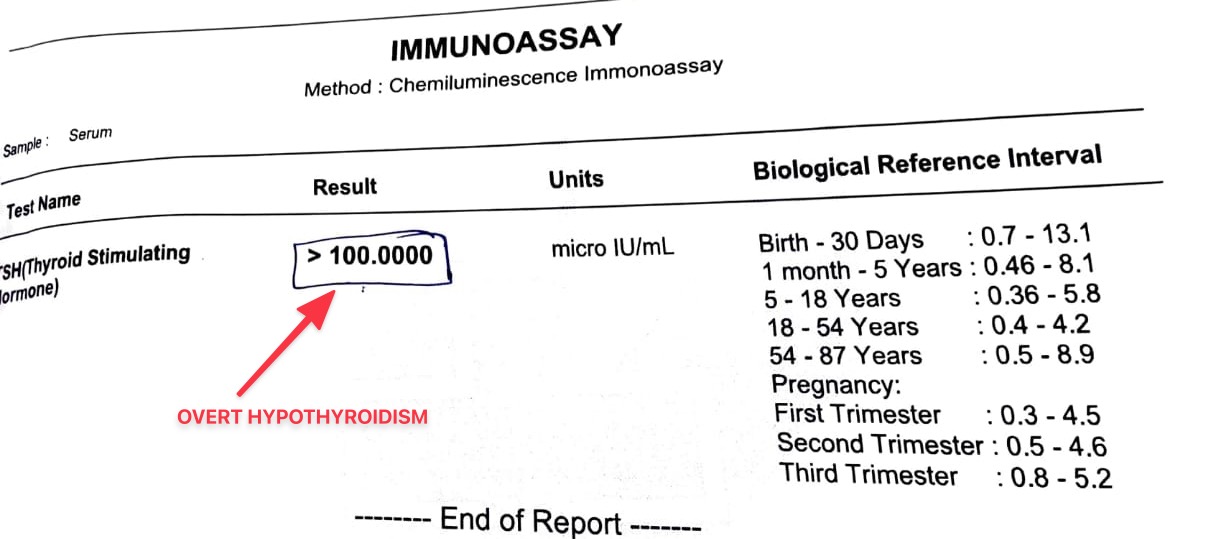Hypothyroidism And Hair Loss
Author: Dr. Om J Lakhani
If you find this useful, please use the link to see the various ways in which you can Support us →
Updated: #jan2025
Corresponding patient information: Is my hair loss because of my thyroid problem ?
-
Q. What is Telogen?
- Telogen phase is when there is the resting phase in the hair growth cycle.
-
Q. What is Telogen effluvium?
- It is one of the most common causes of hair loss.
- It is generally temporary.
- It is caused by any illness or major physiological stress.
- Any stress produces the hair to go into a resting phase, and hair growth ceases temporarily to conserve energy.
- If this is prolonged, then the hair loss soon becomes apparent.
- Such hair loss is transient and often recovers after the underlying illness is corrected.
- Hair loss associated with thyroid dysfunction is often due to Telogen effluvium.
-
Q. What produces hair loss - hypothyroidism or hyperthyroidism?
- Both hyperthyroidism and hypothyroidism can cause hair loss.
-
Q. What is the pattern of hair loss with thyroid disorders?
- Hair loss is generally diffuse.
-
Q. Enlist the patterns of hair loss that may be seen with hypothyroidism?
- A study done on this topic by Vincent et al. shows that the following are the patterns of hair loss seen in hypothyroid patients [1]:
- Diffuse alopecia - most common - 70%
- Alopecia areata - 11%
- Androgenetic alopecia - 14%
- Cicatricial alopecia - 0.32%
- Alopecia totalis - 0.16%
- Alopecia universalis - 0.41%
- Madarosis
- Diminished facial hair - 0.57%
- Diminished body hair - 0.16%
- A study done on this topic by Vincent et al. shows that the following are the patterns of hair loss seen in hypothyroid patients [1]:
-
Q. Does subclinical hypothyroidism produce hair loss?
- Subclinical hypothyroidism is unlikely to cause hair loss.
- This is a common misbelief and often a cause of referral to an endocrinologist.
-
Q. Does the hair loss worsen after hypothyroidism is treated with levothyroxine therapy?
- Yes.
- There is a transient worsening of hair loss with hypothyroidism treatment initially.
- In such cases, paradoxically, the hair loss may follow the treatment for the thyroid, and the thyroid medication may be erroneously blamed, leading to the withdrawal of treatment, which in turn may worsen the hair loss.
- This occurs because of the correction of hypothyroidism within the first month of therapy.
- This is because the resting hair follicle becomes active again and is shed rapidly.
- The new hair that grows, however, is healthy, and in due course, the hair growth improves.
-
Q. Does radioactive iodine therapy for Graves' disease produce hair loss?
- No.
- RAIT does not cause hair loss.
-
Q. Do antithyroid drugs used in Graves' disease produce hair loss?
- Yes.
- Carbimazole and PTU cause hair loss on their own.
-
Q. What is alopecia areata and what is its link with hypothyroidism?
- Alopecia areata is sudden hair loss that starts with one or more circular bald patches that may overlap.
- It is more common in children.
- alopecia areata likely has an autoimmune etiology, and the presence of overt hypothyroidism may have a potential link since it is most often autoimmune.
-
Q. Does the treatment of hypothyroidism improve the outcome in alopecia areata?
- alopecia areata often runs an independent course with hypothyroidism.
- However, there is some improvement seen in clinical practice with levothyroxine treatment.
- This is most likely due to the correction of Telogen effluvium.
-
Q. How do you differentiate hair loss due to alopecia areata versus that of hypothyroidism if they coexist in the same patient?
- Alopecia areata produces regional hair loss, unlike that due to thyroid, which is more diffuse hair loss.
-
Q. Apart from hair loss from the scalp, is there hair loss from other areas in hypothyroidism?
- Thyroid dysfunction can also cause eyebrow hair loss, which is often transient and improves with treatment.
- Body hair may also be lost.
- "Superciliary madarosis" is a classical sign of hypothyroidism taught to medical students. However, it is rarer than we think.
-
Q. What is madarosis?
- Madarosis is defined as the loss or absence of eyelashes (ciliary madarosis) or eyebrows (superciliary madarosis).
-
Q. What are the issues with hair supplements and thyroid?
- Two issues:
- Some supplements may contain iodine and may cause thyroid dysfunction (Please see Iodine deficiency disorders).
- Some supplements may have biotin , which may interfere with thyroid function.
- Two issues:
-
Q. How common is the use of biotin endocrine tests?
- At least 50% of the endocrine tests have biotin in their separation step.
-
Q. Does biotin produce false high or false low?
- Can cause both, depending on the situation.
- False low:
- Large molecules with noncompetitive IMA method:
- C-peptide
- FSH
- TSH
- Prolactin
- Large molecules with noncompetitive IMA method:
- False high:
- Small molecules with competitive assay:
- Progesterone
- Steroid hormones
- T3, T4
- Small molecules with competitive assay:
-
#Clinicalpearl - Since biotin produces false high for T3 and T4 and false low for TSH, wrong diagnosis of Graves' disease is often seen.
-
Q. Where is high-dose biotin used in practice?
- Dermatology - Hair and nail treatments.
- Neurology - Multiple sclerosis.
-
Q. What dose of biotin is likely to cause assay interference?
- biotin dose >5 mg/day is likely to cause assay interference.
-
Q. How long should biotin be stopped before repeating the test?
- Stop for at least 2-3 days.
- Since it is renally excreted, a longer period is needed for patients with impaired renal function.
-
Q. What can labs do to check for biotin interference?
- Use streptavidin beads or other approaches to look for biotin interference.
-
Q. Which other antibody will produce a picture similar to biotin interference?
- Presence of streptavidin antibody will produce a similar picture as biotin interference.
-
Q. Do parathyroid conditions also produce hair loss?
- Yes.
- Parathyroid conditions also produce hair loss.
-
Q. Does central hypothyroidism produce hair loss?
- Yes.
- In females, it produces androgenetic alopecia.
-
Q. What are the other prominent skin findings associated with hypothyroidism?
- Vitiligo.
- Urticaria.
-
- Case capsule:
- 10-year-old child presents to the dermatology clinic with patchy alopecia.
- This is alopecia areata.
- Dermatologist orders a thyroid function test.
- The child is found to have Overt hypothyroidism.


- Case capsule:
Multiple-Choice Questions
-
Question: What is the most common pattern of hair loss seen in hypothyroid patients according to the study by Vincent et al.?
A. Alopecia areata
B. Diffuse alopecia
C. Androgenetic alopecia
D. Cicatricial alopecia
Correct Answer: B
Explanation: The study by Vincent et al. found that diffuse alopecia is the most common pattern of hair loss in hypothyroid patients, accounting for 70% of cases. -
Question: Which of the following statements is true regarding hair loss and hypothyroidism treatment?
A. Hair loss worsens permanently after starting levothyroxine therapy.
B. Hair loss improves immediately after starting levothyroxine therapy.
C. There is a transient worsening of hair loss initially after starting levothyroxine therapy.
D. Levothyroxine therapy has no effect on hair loss.
Correct Answer: C
Explanation: There is a transient worsening of hair loss initially after starting levothyroxine therapy because the resting hair follicles become active again and are shed rapidly. However, the new hair that grows is healthy, and hair growth improves over time. -
Question: What is the primary cause of hair loss in thyroid dysfunction?
A. Alopecia areata
B. Telogen effluvium
C. Androgenetic alopecia
D. Cicatricial alopecia
Correct Answer: B
Explanation: Hair loss associated with thyroid dysfunction is often due to Telogen effluvium, which is a temporary condition caused by physiological stress or illness that pushes hair follicles into a resting phase.
Vincent M, Yogiraj K. A descriptive study of alopecia patterns and their relation to thyroid dysfunction. International journal of trichology. 2013 Jan;5(1):57. ↩︎